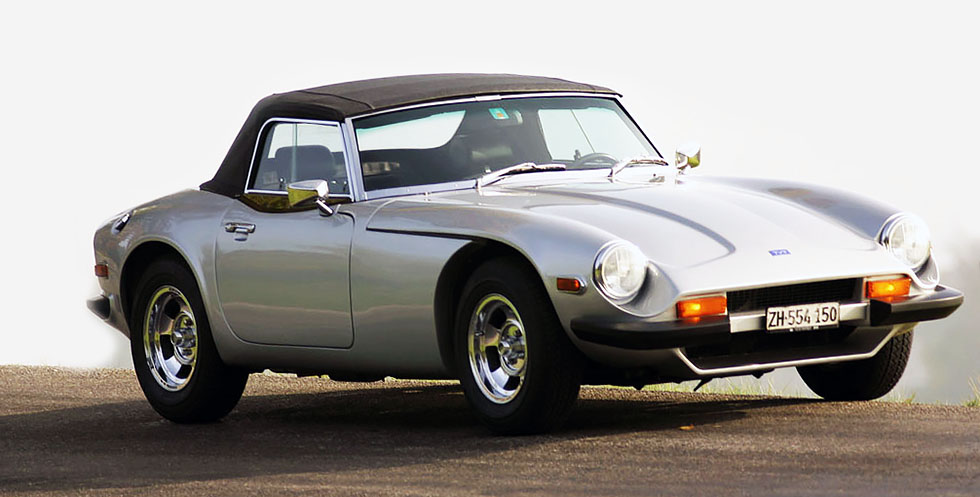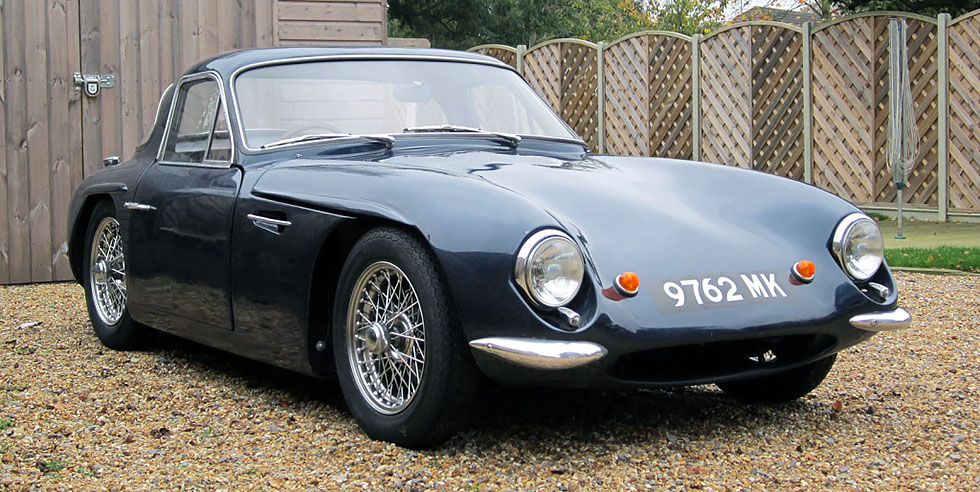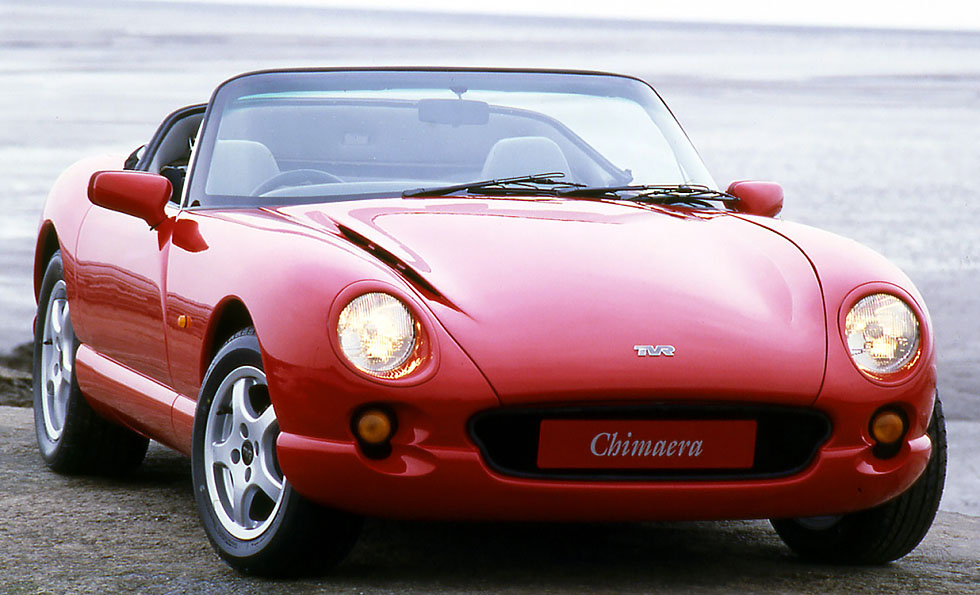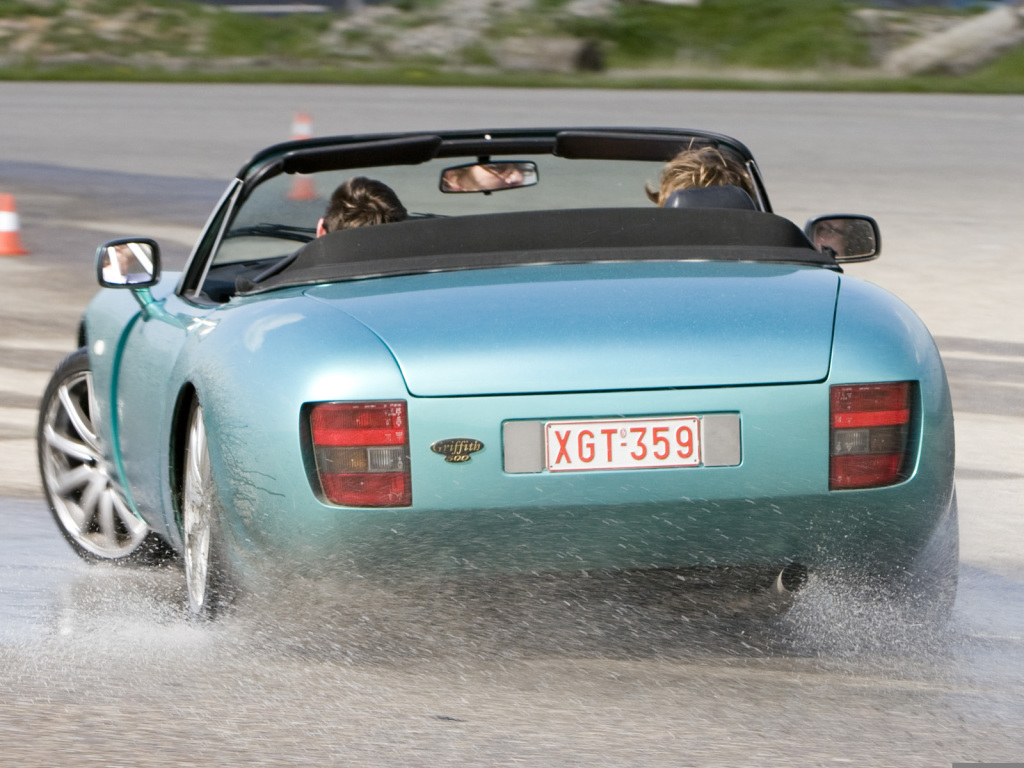
TVR’S glory years. TVR With an all-new TVR just around the corner, now’s the time to chart this sports car builder’s roller-coaster ride from boom to bust and hopefully back again. Words: Iain Wakefield.
Mention the name TVR to a gathering of performance car fans and a pound to a penny the conversation will at some time get round to discussing the pros and cons of some of the fabulous looking but sometimes temperamental V8-powered sports cars the company built during the ’80s and ’90s. The recent news claiming the TVR name is on the way back in the shape of a brand new car designed by Gordon Murray of FI fame will not only be good news for followers of the marque; the announcement should also hopefully see an abrupt transformation in the fortunes of the remnants of this well known company as a car maker.

This latest peak in TVR’s roller-coaster ride from specialist car builder to a producer of wind turbines is a far cry from the firm’s humble beginnings back in 1946 when Trevor Wilkinson formed Trevcar Motors in Blackpool. Although messing around with sports cars was a passion for Wilkinson, the core of his business at the time included fettling ex-military vehicles and repairing the occasional fairground ride. The company changed its name to TVR in 1947 and the first hand-built car Wilkinson and partner Jack Pickard developed in 1949 utilised a multi-tubular frame clad in a home made body under which lurked Morris Eight mechanicals and an 1172cc Ford E93A sidevalve engine.

Unfortunately TVR number one no longer exists as it was damaged in an accident, but TVR number two is still around and currently belongs to a TVR Car Club member. The company’s name was taken from letters in Wilkinson Christian name – TreVoR – and after building Ford OHV powered TVR number three, Wilkinson took the decision to produce body shells for his automotive creations out of glassfibre rather than metal. The choice of this new material proved much easier and cheaper to work with and from 1953 RGS Atlanta bodies were fitted to a revised hand-built chassis fitted with A40 running gear and the new model sold as the TVR Sports Saloon.
TVR went on to manufacture glassfibre bodies at its Blackpool factory and developed a new semi-space frame chassis using a central backbone and independent VW Beetle suspension. In 1965 Wilkinson put an advert in The Motor magazine promoting his new race proven chassis and was contacted by American racer Raymond Saidel to supply unbodied cars fitted with a Coventry Climax engine and MG TC gearbox for use in a Stateside race series. A limited number of these cars were sold in North America as the alloy-bodied MkII Jomar and in the UK up to 1959 with a plastic body and the choice of a Ford engine as the TVR Jomar.
Buoyed by the sales of their chassis in the US, Wilkinson and Pickard appointed Bernard Williams, a local motoring enthusiast as a director at TVR Engineering. Soon after his appointment, Williams introduced Fred Thomas, a wealthy investor to the TVR board. This was a shrewd move, as Thomas would in time along with Williams take much of the financial strain away the two original partners who were happier building cars than juggling figures.

The next car TVR produced was the Sports Tourer, although it was never officially named as such. More key employees were taken on and in 1958 the first generation of the Grantura was launched. Available as either as a self-build kit or a ready to run car, the Grantura contained a heady mix of parts, including Austin-Healey 100 brakes, Triumph or VW Beetle suspension parts and a BMC sourced rear axle. Power came from a range of engines made up of a sidevalve Ford unit, 1.5-litre BMC B-Series or 1098cc Coventry Climax power plant. The windscreen was from a Ford Consul and Granturas sold across the Atlantic were badged as the Jomar Coupé or Grand Turisimo Coupé, depending on the size of power source fitted.
By the end of 1958, TVR-Jomar sales in the US had ground to a virtual halt and although there was a backlog of orders in the UK, the company had a debt at the bank of over £10,000. The directors decided to dissolve the original company and transfer all the assets to a new venture called Layton Sports Cars Ltd. A sister company, Grantura Engineering, was formed to get around UK tax laws regarding the production and sale of kit cars and early in the new year the board voted to replace Trevor Wilkinson with Henry Mould as the firm’s new production manager.
At the time TVR were only managing to produce one car a month and this lead to a huge backlog of orders, an issue combined with reliability problems that resulted in Raymond Saidel ending his relationship with the Blackpoolbased company in May 1959. Continental Motors in Washington became TVR’s new US distributor but this arrangement didn’t last long and cars were returned to the UK when Continental’s owner, Walter R Dickson, was convicted and jailed for fraud. Later that year an ex-Rolls-Royce engineer by the name of John Thurner joined TVR as Technical Director and was immediately given carte blanch over future Grantura development, much to the ire of Wilkinson.
A total of around a 100 MkI Graturas were built and in 1960, TVR had a much-improved MkII version ready for production. Meanwhile, Keith Aitchison and Bryan Hopton were running a TVR and Lotus dealership in Chester and the pair expressed an interest in investing in TVR. After driving a MkII Grantura around Monza, the pair were suitably impressed and went on to purchase a controlling interest in the company. Hopton appointed himself chairman and the firm changed its name from Leyton Sports Cars Ltd. to TVR Cars Ltd. Orders for the new car doubled and in 1962 Ken Richardson joined the company as competitions manager.
Three specially prepared MkIIA Granturas were entered into that year’s Sebring 12-Hour race but only one car managed to finish. The TVR team also raced cars in the 1962 Tulip Rally and 24-Hour Le Mans, a prestige event the cars failed to finish. Richardson’s very expensive and relatively unproductive flurry into motorsport was just one of several reasons why Wilkinson and Pickard resigned from the company in April 1962 to set up a specialised glass fibre company after which Wilkinson retired to Minorca where he passed away in 2008 aged 85. Back in the early ’60s TVR Cars had a workforce of about 50 employees but by late 1962 the company’s finances were again in dire straights. TVR had also lost two important UK distributors and the delayed launch of the MkIII Grantura only compounded matters. TVR Cars Ltd. was forced into receivership in late 1962 and all the assets subsequently transferred to the still trading Grantura Engineering.
Grantura Plastics was formed in 1963 to produce bodies and a new partnership was formed between Grantura Engineering and a London-based TVR centre owned by James Boothby. A revived dealership was formed in the US with Dick Monnich and one of his colleagues was Jack Griffith, a Ford dealer who experimented by fitting a Ford V8 into MkIII Grantura. The result would go on to become the TVR Griffith and although the model sold well in the US, a dock strike in New York resulted in Monnich being unable to fulfil his financial obligation with Ford for the supply of engines. The US contract with TVR subsequently ended and the Blackpool firm once again found itself facing a financial black hole.
Four Trident prototypes were produced in 1965 and following the company’s liquidation, Bill Last, a TVR dealer acquired one and established Trident Cars in 1966 to build a version he named the Clipper. This could have been the end of the TVR marque had it not been for Arthur Lilley and his son Martin who bravely stepped in and purchased the remains of TVR from the receivers and renamed the revived firm TVR Engineering.
The V8-powered Tuscan was unveiled at the start of 1967 and later that year the covers came off the Vixen. Although order books for the new models looked healthy, money was still tight and an ambitious project to build the steel bodied TVR Tina was abandoned after making two prototypes. Between 1969 and 1971 the company launched several uprated models and the Ford V6-powered Tuscan now filled the gap between the four-cylinder Vixens and the V8 powered cars. In 1970 TVR relocated from its cramped Hoo Hill factory to Bristol Avenue in Blackpool and the company caused a storm that year at the London Motor Show when it used a nude glamour model to promote the cars on its stand.
“The company caused a storm that year at the London Motor Show when it used a nude glamour model to promote the cars on its stand”
A project named SM/Zanta to produce a luxurious Harris Mann-styled GT was dropped after a single prototype was built and development funds transferred to the M series, a model that would eventually replace the Vixen range. The M series would result in the launch of the 2500M, 3000M, 1600M, Taimar and 3000S but a fire at TVR’s Bristol Avenue factory in 1975 seriously hampered production. However, the workforce pulled together and the company was soon building cars again. A meeting between TVR directors and noted Lotus designer Oliver Winterbottom in 1977 resulted in the launch of the wedge-shaped TVR Tasmin in 1980. Unfortunately the introduction of the controversially styled Tasmin coincided with a serious global recession and once again TVR found itself in on the edge of a financial precipice.
Another boardroom shuffle resulted in Martin Lilley transferring control of the company to Peter Wheeler, a wealthy businessman and TVR enthusiast, at the end of 1981. This was the year the company moved away from using V6 engines and went over to fitting 5.0-litre Rover-sourced V8’s to most of its cars. TVR did however experiment with other power units such as a Holden V8 and in the ‘90s TVR Power, a subsidiary company, modified a number of Rover V8s before developing the AJP8 engine. This was a lightweight all-alloy V8 developed by Al Melling, John Ravenscroft and Peter Wheeler, hence the unit’s AJP prefix and these in-house built units were offered in the 1996 Cebera and 1999 Tuscan. A straight-six engine, the TVR Speed Six, was also developed and this went on to power a number of the company’s later models.
Under Wheeler’s direction, TVR enjoyed a reasonable amount of success and went on to develop several new models, including the Tamora (2002), T350 (2002), Typhoon (2004) and Sagaris (2004). However, it was all change in the TVR boardroom once again in July 2004 when Russian-born Nikolay Smolensky purchased the company from Wheeler for a reputed £15million. By 2006 demand for TVR’s was falling and 300 staff were laid off. Although it was announced that TVR might be relocating to a new site in Blackpool, Smolensky upset the apple cart when he proposed transferring production to Turin and only retain engine production in the UK, claiming the expiry of the lease on the current factory was forcing the move.
The announcement that TVR production could move overseas prompted a huge gathering of enthusiasts to drive their cars through London in protest of the move. Unfortunately all the publicity was in vain as by the end of the year it was revealed that Smolensky had split TVR up into a number of different divisions and along with production director Mike Penny, promptly resigned from what was now called Blackpool Automotive. Although Roger Billinghurst and Angelco Stamenkov were now in charge at TVR, the company was once again put in the hands of the receivers a few days before Christmas.
In an early New Year surprise move, it was revealed that Smolensky had purchased the remains of Blackpool Automotive from the receivers in February 2007 and was looking to restart TVR Sagaris production at a new site in Lancashire. This sadly never happened and in 2010 a German company with a small share holding in TVR also made an announcement that it was looking at restarting car production and was even planning to produce new models. Again, this proposal came to nothing and in June 2013 Smolensky sold his entire interests in the business to TVR Automotive Ltd, a company owned by UK entrepreneur Les Edgar.
Under the control of Edgar, the revitalised company announced a scheme to guarantee the continuity of spares for existing TVRs with the launch of a new company, TVR Parts Ltd. With the interests of classics TVRs covered, Les Edgar stunned the motoring world in 2015 when he revealed the development of a brand new TVR ‘supercar’ was well underway in conjunction with partners Gordon Murray and Cosworth. The specification of the new car is impressive to say the least and it will feature a front-mounted Cosworth developed V8 powerplant driving the rear wheels and will be followed by additional models as part of the company’s comprehensive ten-year plan.
Order books for the new TVR are filling up rapidly and deposits have already been taken for the new sports car, which will be launched in 2017. As yet no decision has been taken where the new TVR will be built but a return to the company’s spiritual home in Blackpool seems highly improbable. There again so was the announcement by Edgar that a brand new TVR will be in the showroom in two years time, so we’ll just have to wait and see as this company has never been short of pulling a few V8 powered rabbits out of the hat in the past.

Cerbera was the first 2+2 of the Wheeler era and debuted TVR’s own engine.

Chimaera was TVR’s idea of a softer grand tourer… but was still brutally quick.

The wedge shape first launched with the Tasmin defined TVR’s style during the 1980s.

The V8S chassis was found underneath the first Griffith concept. The Griffith was the first all-new design from TVR since Peter Wheeler took charge. In TVR hands, the Rover motor was eventually taken up to 5.0-litres. The V8S blended traditional looks and Rover V8 power for the first time.





